#great hypostyle hall
Text
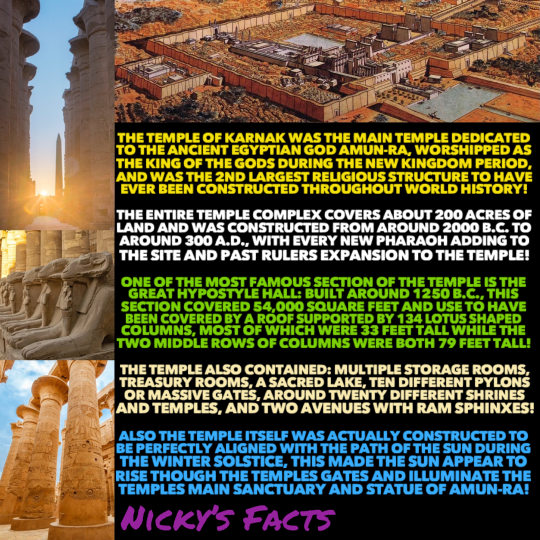
The Temple of Karnak, truly a Wonder of the World!𓉹
#history#temple of karnak#ancient egypt#architecture#ancient history#amun ra#great hypostyle hall#egyptian art#winter solstice#landmark#art#egypt#world heritage site#luxor#wonder of the world#travel girl#ancient egyptian history#astronomy#egyptology#classical age#thebes#ancient#architecture history#kemetic#new kingdom#religious sites#ancient egyptian art#nickys facts
2 notes
·
View notes
Text
Karnak Temple
After 3 days in Cairo, Leah and I were on the move! We boarded a chartered prop jet with our fellow river cruisers and flew to Luxor, to greet the Viking Ra--currently tied up alongside the Nile's east bank. Ra was to be our floating hotel...
After 3 days in Cairo, Leah and I were on the move!
We boarded a chartered prop jet with our fellow river cruisers and flew to Luxor,
to greet the Viking Ra–currently tied up alongside the Nile’s east bank. Ra was to be our floating hotel through the following week.
After attending an obligatory safety briefing aboard Ra,
we were soon exploring Luxor and it’s ancient counterpart, Thebes–home…

View On WordPress
0 notes
Text
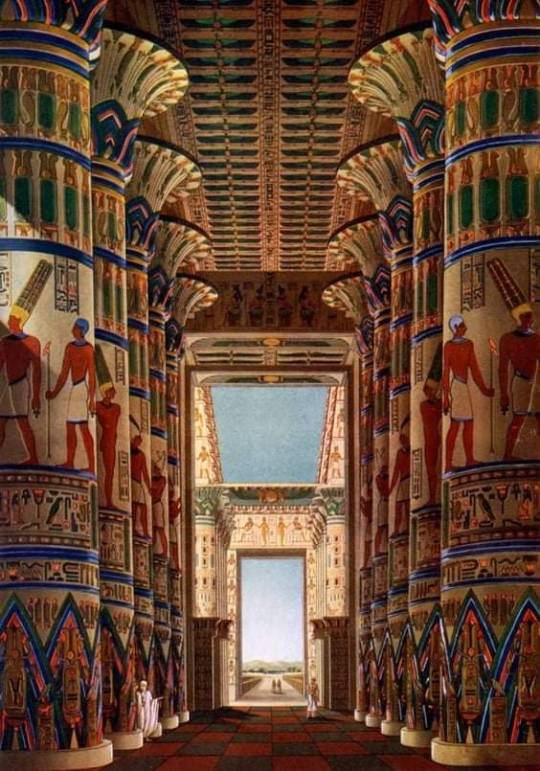
The Great Hypostile Hall of Karnak - Luxor, EGYPT
48 notes
·
View notes
Text
Meditation Before the Temple, part I
“The image one has of the temple is usually that of a house constructed by man. Beneath the immense sky, a very small building indeed.
But for man confronting himself, for Ego, the site of his presence is the centre of his world. Yet there is what man looks at, and there is what is looked at in him. What he sees outside of himself is partial; what sees within him is all. What man puts of himself into his work is everything for him; the work in itself is of small account.
Man has searched within himself for his raison d’être, for the cause of his being, and, on his scale, he has surmised an order for the becoming of all things. To his measure. Unable to find an initial, tangible, and definable cause, he calls it God. This having come out of himself, made in his own image, he builds a house for his God. For it is so difficult to pray beneath the starry sky!
This house is always the symbol of the man who has constructed it. It is the house of a god. It is not the temple, as the temple is not in the image of the man who built it but in the image of cosmic man within terrestrial man. The latter image is what the temple explains.
To work creatively means to concretise, to make palpable sensorially what spirit conceives. This is birth, and therefore shall be death as well.”
— R. A. Schwaller de Lubicz, The Egyptian Miracle
* * *
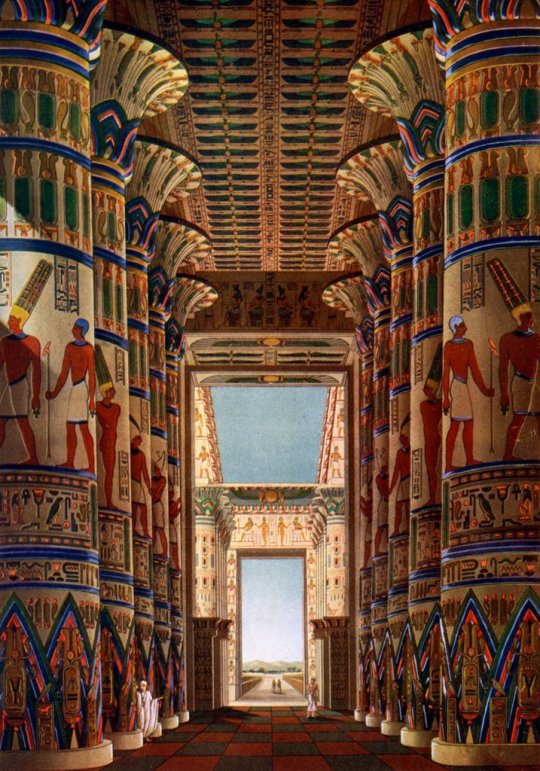
The Great Hypostyle Hall of Karnak (1908)
Illustration from Penrose’s Pictorial Annual
An Illustrated Review of the Graphic Arts, vol. 14
#Meditation before the Temple#Temple#Meditation#R.A. Schwaller de Lubicz#Wisdom#Ancient Egypt#Man#Evolution#Sacred Mysteries#The Great Hypostyle Hall of Karnak#Temple of Karnak#Art#Beauty#Illustration#The Egyptian Miracle
46 notes
·
View notes
Text
The Temple of Dendera Egypt
Pondering the Ceiling at Dendera Temple
Yesterday I visited Dendera – the Temple of Hathor, a one-hour drive from Luxor. Dendera lies along the Nile River near the small Egyptian town of Dendera. The temple was “inhabited in prehistory as an oasis on the west bank of the Nile, south of Qena”. The complex was less crowded than the tours I’ve taken in Luxor.
Aerial View Dendera Temple – Viator
It’s…
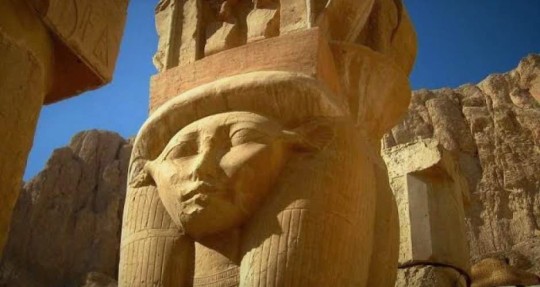
View On WordPress
#Astronomical Ceiling Hypostyle Hall Dendera#Bedouins#Birthing Temple#Chapel of Osiris Dendera#Cleopatra VII Philopator#Coptic Christian Church#Dendera Crypt#Dendera Great Vestibule#Dendera Lightbulb#Dendera Temple#Dendera Underground Crypt#Dendera Zodiac#Egyptian and Greco-Roman Period Rulers#Egyptian Goddess Hathor#Egyptian Hieroglyphs#Egyptian pharaohs. Temple of the Goddess Isis#Eye of Horus#God Bes#Hathor Egyptian Sky Goddess#Ihy Son of Horus#Isis#Luxor Egypt#Main Dendera Temple Dedicated to Hathor Egyptian Sky Goddess#Nut (Nuit) Egyptian Sky Goddess#Osiris#Ptolemy XII – Macedonian King of Egypt#Ptolemy XV Philopator Philometor Caesar (Caesarion)#Queen Cleopatra VII. Queen Cleopatra#Sanctuary of Hathor#Sanctuary of Horus
1 note
·
View note
Text

The Sweeper, Great Hypostyle Hall, Karnak, Egypt, Photo by Carolyn Brown, 1989
630 notes
·
View notes
Text

Left to right: Neith; Amun-Re; Ramesses II, kneeling; and Mut-Werethekau. The gods are granting the king many jubilees (the sed festival, held after thirty years' reign and every three-four years after that). The Great Hypostyle Hall at Karnak.
67 notes
·
View notes
Text

The god Horus wore the red crown of Lower - Egypt. Horus, the sky god seen as a falcon, is the image of the living king. The king is represented as Osiris after death. Relief from one of the chapels, the chapel next to the Hypostyle hall. The great temple of Seti (13 AD)
Abydos
59 notes
·
View notes
Text
CYNO: # those who trespass.

word count. 2k. genre. adventure, platonic.
overview. with false rumours spreading that your research at the akademiya is concerned with forbidden knowledge, you travel across the desert to prove the subject's validity and your own integrity. but the lies seemed to have reached the ears of a certain law-upholding mahamatra.
warnings. fear, slight claustrophobia, one (1) bad joke from cyno. childhood best friends to percieved strangers trope ?

You had never expected to find yourself in the dry heat of the Hypostyle Desert, collecting information on the mystery of ancient times before. You were out of the direct sunlight, deep underground within the ruins of a temple, and you were close; you could feel the hair on your neck rise in anticipation. This room of the temple was the one you had been meant to find, and the thick pillar with the goat statue atop was the site which would hold the answers. As always, the answers would lead to more questions, but even a report of what you knew you would discover hidden in that pillar—the ancient power, and more importantly, the ancient tale—would carry you away from the endless respite from progress. It had only been luck that had led you here—luck, and some fear of lies that had followed you. Yes, this would be it, that last piece that would reclaim for you the reputation you sought.
But said lies you now heard the footsteps of, echoing dramatically down the long stone hall behind you.
“There’s nowhere for you to run.” The General Mahamatra—for you knew it was him—rather harshly stated your own thoughts aloud.
You knew it to be true, and yet you were not ready to give up. “There’s no grounds on which you can arrest me,” you declared, facing him more boldly than you felt. You mustered up the strength to look in his scarlet eyes. Your fear increased rapidly. Judging from his stance, staff held out to prevent any of your attempts of escape… he seemed to be beyond showing mercy.
“What gives you that impression?” At the General Mahamatra’s threatening gaze, you could feel your confidence begin to shatter. Even though you knew you hadn’t broken the law, you were beginning to feel the guilt of someone who had. The case had nothing to do with you. You didn’t even know where the rumours had started; only that you had been tracked here by the upholder of justice. He wasn’t Cyno to you anymore, nor he had he been for years. Clearly, things had change.
“If you lie to me, do not expect me to protect you from the law just because of our past friendship. Justice shall reveal your sins even as your lips tell falsehood.”
“For the last time, I had no part in it!” you said, feeling your voice hesitate. It seemed to be too late for your emotions to help declare sincerity.
“Then tell me,” he said, “why you fled to the furthest reaches of the Great Red Sands the day word spread of the project? A fair trial would have allowed you innocence. You are using forbidden knowledge as a crutch in your studies, and I will not regret.”
You could not speak again, because you knew this was going nowhere. The cold pillar behind you was all you could cling onto to steady your trembling.
The General Mahamatra eyed the pillar behind you, as if he noticed something worthy of suspicion.
Was it you shaking, or the pillar?
Before you had a chance to process what was happening, the General Mahamatra suddenly lunged towards you. It was hard to tell quite what had occurred in the moment that took you from beside the pillar to several feet down the stone hall, but you could faintly identify the feeling of hands leaving your torso and a blinding flash of Electro, as well as brief but overpowering motion.
Then, a sound like waves of fire exploded from the room, and it appeared that the entire chamber might come crashing down atop of you. As you readjusted your eyes, you could see that the pillar had been dispelled, and a great orange light with a peculiarly—familiarly—shaped artifact hung in the center of it.
Yes, you had been close to discovering the secret. But you might spend your life in prison before ever getting to finish your research, now.
It was growing hotter in the hall; you could only wonder if your skin might have melted off had you stayed next to the pillar. Had… had you not been saved by…?
The General Mahamatra stood at the wall opposite you, also peering into the room in faint wonder. He seemed to have forgotten your perceived sins for the moment, the awe of the relic consuming his mind as much as yours.
You knew what this was, however. This was the hilt of a weapon once wielded by a descendant of King Deshret, as far as your research had led you to believe.
Recalling a scroll you had read on a related weapon, you wondered what might be making this piece so unstable. Was it the presence of a similar weapon? Or… some unresolved curse?
“The cycle of seven must be removed….”
A voice groaned from within the fiery glow.
Perhaps it was all of the above. A glance at the General Mahamatra seemed to confirm this; he was holding his weapon with wide eyes, as it seemed to be dragged by some invisible force towards the flame. If he didn’t let go of it now, it might drag him into the center of the heat.
Your thoughts whirled as you shouted, “Cyno! We have to get out of h—”
The General Mahamatra would not be getting out of here quite yet. He raised his staff, drawing Electro into a swirl of mulberry purple around him, and his attire seemed to change as the designs on his hood glowed. His arm changed colour too, and in place of his hand a large and terrible claw took form. He stepped once towards the room, and then took two more steps, crackling with Electro might. He drew back the claw and then released the gathered element at the artifact in increasingly powerful waves.
You could not look away, but you could not fully gaze upon the destruction. The artifact, the hilt—it seemed to wither away, and with it, the amber light. It did not cool, as the General Mahamatra did not release his form just yet. He had noticed the ceiling of the room caving in before you might have even thought to look. His claw now supported it, and he looked you dead in the eye.
“Run now, or join the ancients in their grave,” he snarled.
You ran.
—
“You called me Cyno.”
You craned your neck to look over your shoulder from the boulder you sat on outside the ruins. “My apologies,” you said, with less gusto than the comment deserved. The General Mahamatra walked around the boulder, eyed it, and sat right next to you, curtly dusting debris off of himself. You were somewhat relieved to see that he made it out in one piece.
“It does not matter what you call me,” he reprised, “for it does not impact my authority nor the law’s.”
“So what’s your point?”
“Well,” he said, and cleared his throat. He seemed to endeavor eye contact with you, but tore his gaze away after only a moment. This was strange. This was different than five minutes ago underground.
“Well?” you repeated.
“Yes. It made me think to our day. When we were younger. When I was Cyno, Defender of the Law, to you.”
You cleared your throat. “Cyno, Defender of the Law, and Scarlet Sand Authority of Justice.” You felt a bit shy saying something outright like that with the potential of embarrassing him. Especially after seeing how far his capabilities with his vision had come.
“Yes. I was reminded of that.”
Thankfully, he seemed unphased. You ventured to ask, “Aren’t you about to arrest me?”
He cleared his throat. You watched a short smirk form on his face and disappear just as quickly. “No, I need to rest myself first.”
“Hmm. You mean justice can wait for your minor fatigue?”
“No, I…” He looked you earnestly in the eye. “It was a joke.” As you did not immediately respond, he continued. “See, because you said you expected me to ‘arrest’ you, and because I have just exerted myself rather extremely in the ruins, I am in need of ‘a rest.’ So, I responded—”
“I get it, Cyno.”
“You do? You’re not laughing. Was it my delivery?”
You frowned. After all the fear that had led you here, along with the slightly crushing disappointment that your research could not continue on this subject now that the relic had been destroyed by a certain someone, you weren’t really sure what to feel right now. Especially with the General Mahamatra—Cyno, your old friend who you had not seen in years—cracking the same old dry jokes after threatening you with a glaring gaze and justice.
“So, can I call you Cyno again?” you asked.
“You may,” he replied.
“Okay, then, Cyno. What happened to my criminalization?”
“It was a matter of ruling you out. You would not admit to it, nor would you provide any evidence other than that of a dangerous pursuit. Now that the danger has been dispelled—”
“Wait, wait, wait,” you interrupted. “You tracked me down to the desert to keep me from searching for the relic?”
He blinked. “Not quite. I had planned to have you go through trial, and ban you from the topic altogether.”
“That wouldn’t have been very nice.”
“Oh, it would have been better for everyone involved. Do you realize what might have happened if I hadn’t been there to stop you just now?”
“I—” you faltered. Because, no, you did not realize. You hardly knew what set off the relic, much less what Cyno had done to destroy it. “Why didn’t you stop me before I got that close? Or at least be honest with me about it instead of making me panic like that?”
“You are not the kind of person who turns around at warnings of danger. That much is clear from your continued pursuit of the subject, as well as my experience as your acquaintance.”
“Acquaintance? Cyno, we were best buds a few years back!”
“Alright. As your former best bud, I know you to be reckless with your life in the pursuit of knowledge and prestige. In the name of justice, I took it upon myself to keep an eye on your endeavors.”
“In the name of justice?”
“Yes.”
“More like, in the name of a creepy former best bud who’s been watching me for years since we took different paths.”
“I disagree. That is an unfair statement. No, it was in the name of saving your life, and you cannot refute that.”
“I can try.”
“Indeed, you can try because you’re not dead in the ground.”
You clicked your tongue. He had you there.
“Well,” you said. You could not think of what to say next.
“Well?” he repeated. He had a serious look on his face, as always, but the response was so impish that you wanted to slap him.
“At least I’m not getting locked up,” you finally said.
You had never expected to find yourself in the dry heat of the Hypostyle Desert, once again chatting with an old and dearly beloved friend, who you had thought, some ten minutes ago, was going to kill you.

author's note: yippee cyno. reblog if you agree 🔥🔥🔥
➳ GENSHIN MASTERLIST
#favoniuslibrary#cyno#genshin x reader#cyno fluff#cyno angst#cyno gi#ff#genshin platonic#genshin scenarios#cyno platonic#cyno imagine#genshin impact x gn!reader#gi x you#can u tell i think he's pretty cool. i like him even#i do not attempt to deny that i think very highly of him#lol guess who is NOT editing this#cause i'm TIRED
128 notes
·
View notes
Text
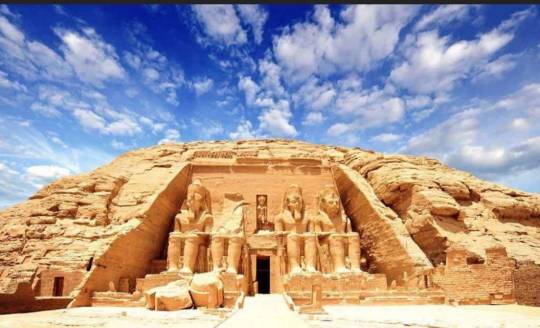
Great Temple of Ramses II
Abu Simbel, Egypt, Africa
... looks familiar ?
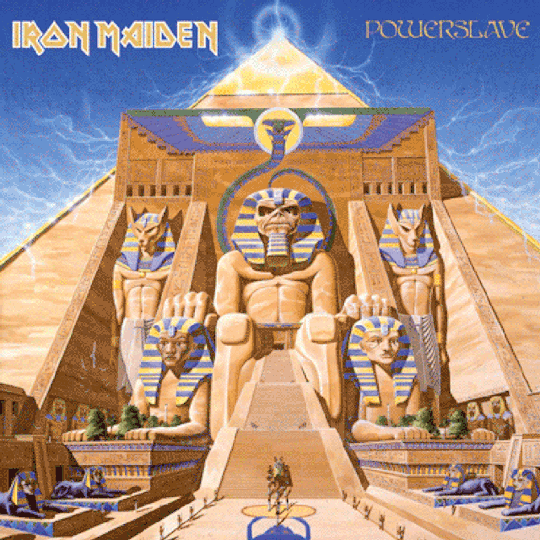
youtube
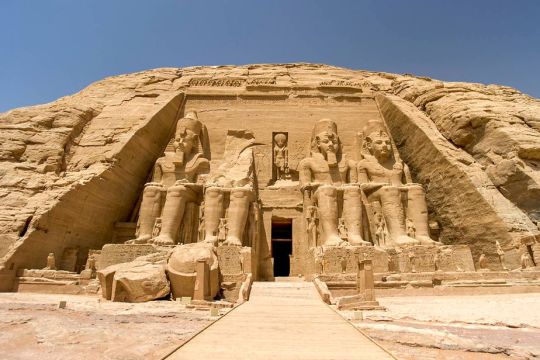
Carved out of the mountain on the west bank of the Nile between 1274 and 1244 BC, this imposing main temple of the Abu Simbel complex was as much dedicated to the deified Ramses II himself as to Ra-Horakhty, Amun and Ptah. The four colossal statues of the pharaoh, which front the temple, are like gigantic sentinels watching over the incoming traffic from the south, undoubtedly designed as a warning of the strength of the pharaoh.

Over the centuries both the Nile and the desert sands shifted, and this temple was lost to the world until 1813, when it was rediscovered by chance by the Swiss explorer Jean-Louis Burckhardt. Only one of the heads was completely showing above the sand, the next head was broken off and, of the remaining two, only the crowns could be seen. Enough sand was cleared away in 1817 by Giovanni Belzoni for the temple to be entered.

From the temple’s forecourt, a short flight of steps leads up to the terrace in front of the massive rock-cut facade, which is about 30m high and 35m wide. Guarding the entrance, three of the four famous colossal statues stare out across the water into eternity – the inner left statue collapsed in antiquity and its upper body still lies on the ground. The statues, more than 20m high, are accompanied by smaller statues of the pharaoh’s mother, Queen Tuya, his wife Nefertari and some of his favourite children. Above the entrance, between the central throned colossi, is the figure of the falcon-headed sun god Ra-Horakhty.
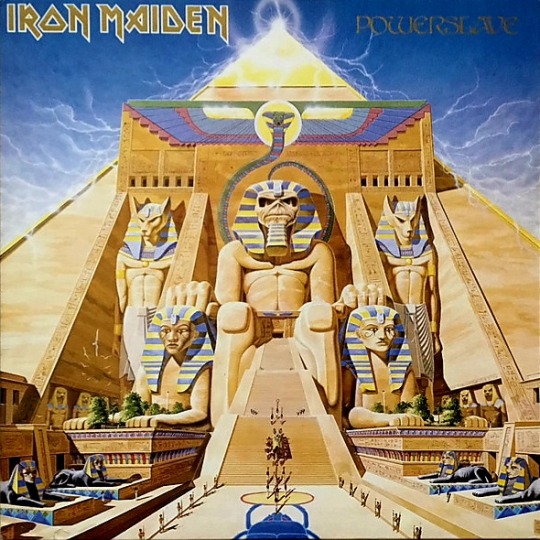

The roof of the large hall is decorated with vultures, symbolising the protective goddess Nekhbet, and is supported by eight columns, each fronted by an Osiride statue of Ramses II. Reliefs on the walls depict the pharaoh’s prowess in battle, trampling over his enemies and slaughtering them in front of the gods. On the north wall is a depiction of the famous Battle of Kadesh (c 1274 BC), in what is now Syria, where Ramses inspired his demoralised army so that they won the battle against the Hittites. The scene is dominated by a famous relief of Ramses in his chariot, shooting arrows at his fleeing enemies. Also visible is the Egyptian camp, walled off by its soldiers’ round-topped shields, and the fortified Hittite town, surrounded by the Orontes River.

The next hall, the four-columned vestibule where Ramses and Nefertari are shown in front of the gods and the solar barques, leads to the sacred sanctuary, where Ramses and the triad of gods of the Great Temple sit on their thrones.

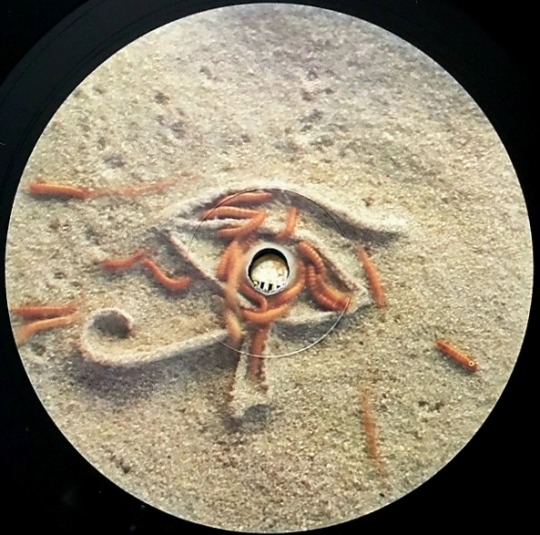
The original temple was aligned in such a way that each 21 February and 21 October, Ramses’ birthday and coronation day, the first rays of the rising sun moved across the hypostyle hall, through the vestibule and into the sanctuary, where they illuminate the figures of Ra-Horakhty, Ramses II and Amun. Ptah, to the left, was never supposed to be illuminated. Since the temples were moved, this phenomenon happens one day later.
youtube
20 notes
·
View notes
Text

Ramesses II ruled the Nile Valley and the wider Egyptian empire from 1279 to 1213 B.C., one of the longest reigns in pharaonic history. He was a cultural innovator, a relentless self-promoter, and an astute diplomat—the peace treaty signed after the Battle of Kadesh was the first in recorded history. He outbuilt every other Egyptian pharaoh, leaving behind the temples of Abu Simbel; the great hypostyle hall of Karnak; the tomb for his wife Nefertari; and his own memorial, the Ramesseum.
His reputation eclipsed that of all other pharaohs as well: he was decried in the Bible as a despot, famed in literature as Ozymandias, and lauded by early antiquarians as the Younger Memnon. His rule coincided with the peak of ancient Egypt’s power and prosperity, the New Kingdom (1539–1069 B.C.).
The subsequent history of Ramesses’ mummy is every bit as dramatic as his initial reburial and rediscovery. In 1975, a French doctor, Maurice Bucaille, noticed that the body, kept under inadequate conditions at the Egyptian Museum in Cairo’s polluted city center, was deteriorating rapidly.
At the request of the French government, it was flown to Paris for scientific study and treatment. The international media, always eager for a sensational story concerning ancient Egypt, concocted a false report that the pharaoh had been issued with an Egyptian passport, which gave his occupation as “King (deceased).”
What is true is that the mummy was greeted on arrival at Paris’s Le Bourget airport in September the following year with full military honors before being taken to the Musée de l’Homme for examination.
In this authoritative biography, Toby Wilkinson considers Ramesses’ preoccupations and preferences, uncovering the methods and motivations of a megalomaniac ruler, with lessons for our own time.
— Ramesses the Great: Egypt’s King of Kings, by Toby Wilkinson
4 notes
·
View notes
Photo

The Great Hypostyle Hall in the Precinct of Amun-Re at Karnak. Constructed during the reign of Seti I and completed by his son Ramesses II.
52 notes
·
View notes
Text
Karnak Temple
After 3 days in Cairo, Leah and I were on the move! We boarded a chartered prop jet with our fellow river cruisers and flew to Luxor, to greet the Viking Ra--currently tied up alongside the Nile's east bank. Ra was to be our floating hotel...
After 3 days in Cairo, Leah and I were on the move!
We boarded a chartered prop jet with our fellow river cruisers and flew to Luxor,
to greet the Viking Ra–currently tied up alongside the Nile’s east bank. Ra was to be our floating hotel through the following week.
After attending an obligatory safety briefing aboard Ra,
we were soon exploring Luxor and it’s ancient counterpart, Thebes–home…

View On WordPress
0 notes
Text
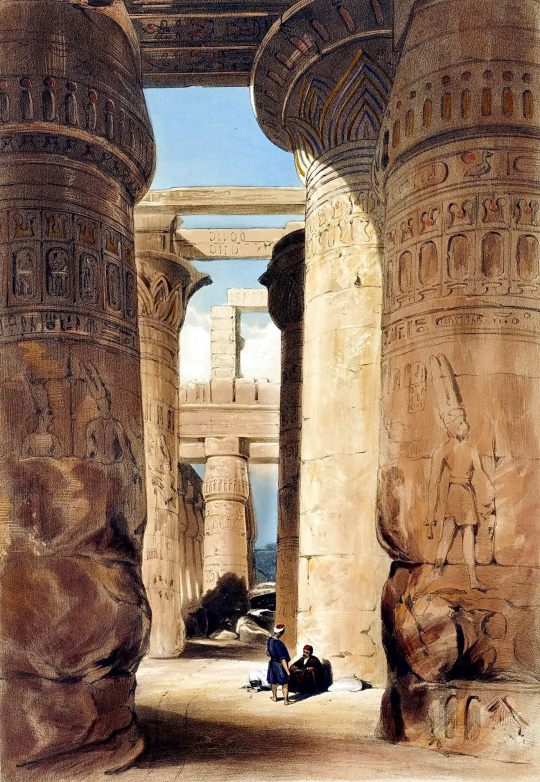
Great Hypostyle Hall , Karnak , Luxor 1845
BY Henry Pilleau
5 notes
·
View notes
Text
56. Great Mosque


Found in Cordoba, Spain
Umayyad
Created c. 785-786 CE
Stone masonry
Visual: As shown, the hypostyle hall is famous for its striped arches and many columns. The mihrab, also dubbed the "horseshoe mihrab," is donned with many shards of gold pieces surrounding the entrance to the prayer room with blues, blacks, reds, and golds. This makes the mihrab look elegant and ornate.
Context: All mosques have to have a place of prayer that is facing Mecca, which is what the mihrab is for. The horseshoe arch was first brought by the Visigoths, but was later used by the Muslims and is a staple in Islamic architecture. There is no record of who built this Mosque, but it was built during the Umayyad Dynasty.
6 notes
·
View notes
Text


King Ramesses II
This is the upper part of a colossal seated statue, one of a pair flanking the entrance to the hypostyle hall in the king's mortuary temple (the 'Ramesseum').
The statue was carved from one block, quarried at Aswan almost 200 kilometres further south. Roughly shaped and weighing some 20 tonnes, it was transported on sleds over land and on a purpose-built boat down the river Nile. Once erected, the finer sculpting was completed. Like all Egyptian statues, this was originally painted. Traces of pigment remain: black for the eye pupils, red for the skin, and blue and yellow for the stripes on the headcloth.
Ramesses II erected more colossal statues than any other pharaoh. Those at the Ramesseum are among the finest, showing the technical skills of the sculptors. Ramesses encouraged popular cults in which he was deified. Many of his colossi had their own name and were a focus for prayers.



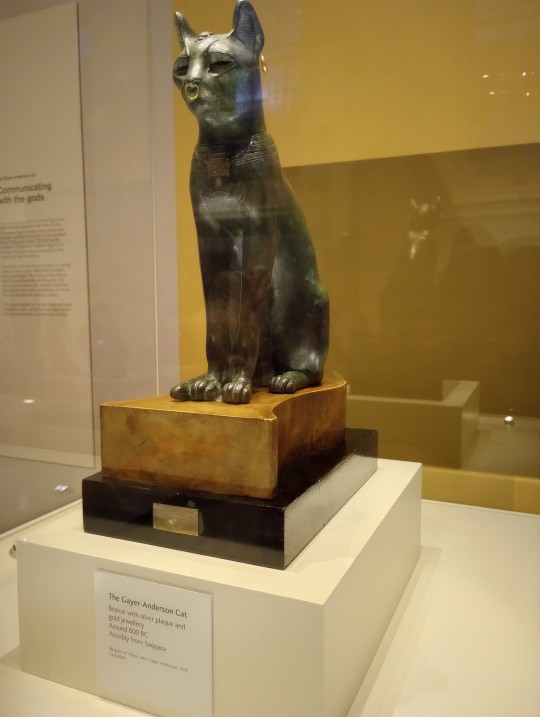
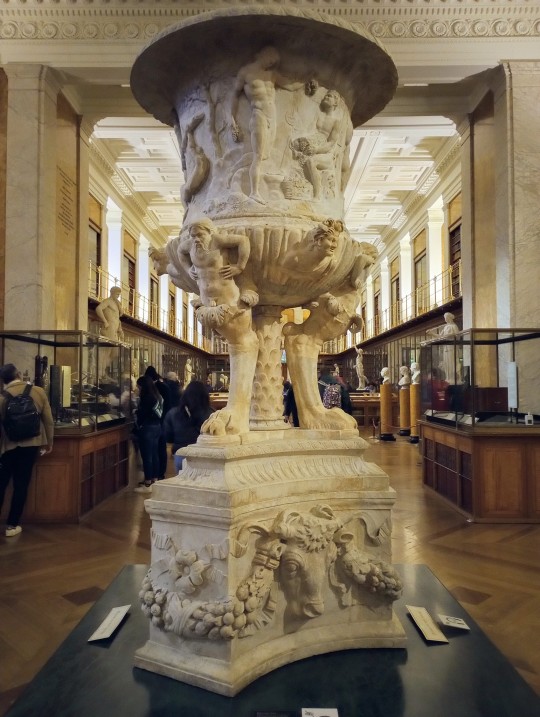
PIRANESI VASE
Roman, 2nd century AD fragments of a decorative vase and several other monuments incorporated into Italian 18th-century composition.
Ornamental vase with relief decoration showing satyrs at vintage, on a triangular base. Designed by Giovanni Battista Piranesi (1720-78) and restored in his workshop. According to Piranesi discovered at the villa of the Roman Emperor Hadrian at Tivoli in 1769.
Acquired by Sir John Boyd for his country mansion Danson House before 1778.



Colossal scarab
This is one of the largest representations of scarab beetles to survive. It also ranks among the last great statues of any pharaonic deity. The scarab represented Khepri, the form assumed by the sun-god at dawn. The Egyptians noticed that scarabs hatch from buried dung balls as if by self-creation. The sun-god was also believed to be self-creating, renewing his powers each night before his rebirth at daybreak. Each sunrise was a repetition of the god's first appearance at the dawn of time as the creator god Atum.
5 notes
·
View notes